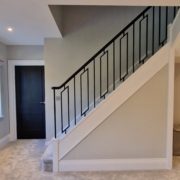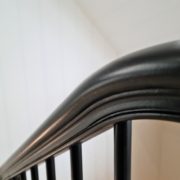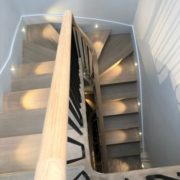What are newel posts and do I need them?
One of the most common questions we get from homeowners, designers and contractors alike is: do I actually need newel posts on my staircase? The quick answer? Not necessarily.
In fact, at Handrail Creations, our entire balustrade and handrail offering is built around the idea that newel posts aren’t essential – as long as your staircase is properly designed and expertly installed.
What are newel posts?
Traditionally, newel posts are vertical uprights found at the start and end of a staircase. You might also find them at intermediate landings or corners where the staircase changes direction. Their primary role has always been structural – anchoring the balustrade, securing the handrail, and providing support for the spindles.
They can also serve as a decorative feature, with many staircases using them to introduce architectural flair, whether through sleek modern styles or more ornate, hand-turned designs. However, the function of a newel post has changed dramatically with the advancement of modern staircase design and manufacturing.

Why do we design without newel posts?
The reality is, you don’t need newel posts – so long as you have a robust and continuous handrail system, and a secure method of fixing the spindles. With today’s technology, a well-designed bannister can maintain full compliance with UK building regulations without relying on traditional upright posts.
Instead, we use specialist fixing methods tailored to each staircase. For example:
- When working with steel spindles, we generally fix them directly into the stringer. We recommend a minimum stringer width of 40mm to prevent breakout and ensure a secure hold.
- On staircases that were originally designed for timber spindles, which usually have a 30mm stringer, we’ll either secure the spindles into existing newels or add a custom-made baserail to provide the extra depth needed for safe installation.
- For new timber spindle installations, newels may occasionally remain in place for structural reasons – but even then, they can be shortened and finished with a neat cap for a minimal look.
The result is a smooth, flowing staircase free of bulky visual interruptions – perfect for contemporary homes and commercial spaces aiming for an open, elegant feel.
When might you still want newel posts?
There are cases where including newel posts might still make sense. For example:
- On staircases with multiple landings or changes in direction, posts may provide extra structural reinforcement.
- If the design includes features like volutes or curtail steps, a subtle or low-profile post might be used to create a polished finish at the start of the handrail.
- In restoration projects or period homes, newel posts might be retained or replicated to stay in keeping with the original architecture.
And of course, some clients simply prefer the look of a more traditional bannister. If that’s you, we offer a full range of newel post styles, from square and chamfered to turned, fluted, or fully bespoke designs, all made to order using advanced CNC machining and hand-finishing.
Newel post styles

Newel posts can provide structural support to a staircase, but they also offer a great opportunity to add style and character to your balustrade. Available in a wide range of materials – from classic pine and oak to sleek stainless steel and wrought iron – they can suit both traditional and modern interiors. Mixed-material designs, such as wooden handrails with metal spindles, are a popular choice for creating a bold, contemporary look.
Learn more about the advantages and disadvantages of these balustrade materials in our blog post on wooden vs metal handrail design.
Styles vary from clean-lined square posts and decorative turned designs, to chamfered edges, barley twists, and fluted finishes. You can also customise the look entirely with bespoke newel posts, designed using CAD software and finished with precision CNC machining or hand-carving – which you can learn more about in our CNC machining guide.
With so many options available, newel posts can become a stylish focal point as well as a practical addition to your staircase.
Do newel posts affect building regulations?
While newel posts themselves aren’t strictly required according to Part K of The Building Regulations 2010, the handrail and spindle system must still meet certain safety standards. These include:
- A handrail height between 900mm and 1000mm above the pitch line or floor
- Gaps between spindles or balusters must not exceed 99mm
- Handrails are required where there’s a drop of over 600mm
- Stairs wider than 1 metre must have handrails on both sides
Our designs account for all of this – with or without newel posts.
Making the right choice for your staircase
At the end of the day, deciding whether to include newel posts comes down to your staircase layout, building requirements and your personal design vision. Our team will guide you through the options, helping you decide whether a minimalist, post-free staircase or a more classic look is the best fit.
Whatever your preference, we’ll help you achieve it – flawlessly manufactured, regulation-compliant, and built to last. Get in touch with us to discuss your staircase project or to book a design consultation.











Leave a Reply
Want to join the discussion?Feel free to contribute!